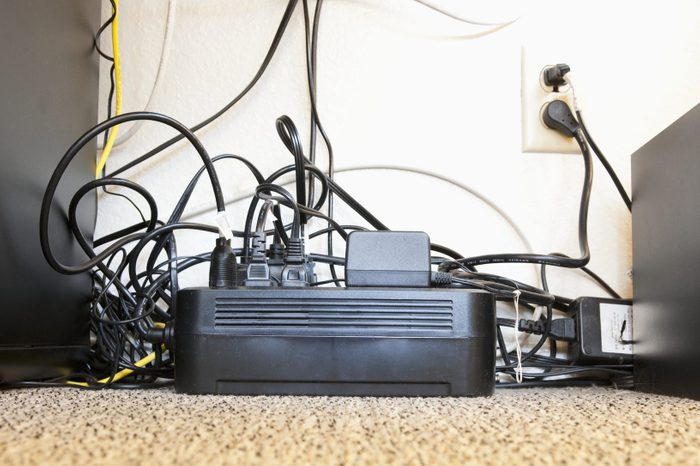Which Household Appliances Are Draining Electricity?

Hitting the power button doesn't always mean an appliance is completely off. Appliances drain electricity in standby mode and the costs can add up.
Our editors and experts handpick every product we feature. We may earn a commission from your purchases.
It’s hard to find an appliance that actually turns off these days. Even when we hit the switch, things continue in the background. Sometimes they use as much “standby power,” spent just waiting, as they do performing their designed function.
Standby power runs internal clocks in microwaves. It keeps your refrigerator’s thermometer running. It also allows devices to sleep, waiting to be nudged awake. Sometimes called vampire or phantom energy, standby power means many of your appliances run 24 hours a day.
When we talk about appliances, we often mean toasters, dryers and dishwashers. Machinery and motors spring to mind, not sensitive electronics. But in today’s homes, televisions, computers and other more intricate devices often outnumber traditional nuts-and-bolts appliances.
Not to mention, old-school appliances now have complex electronic capabilities. If we’re trying to save electricity, it pays to have a broader definition. Merriam-Webster says an appliance is “an instrument or device designed for a particular use or function.” Let’s roll with that.
Which appliances draw the most standby power, and what can we do about it? Let’s find out.
On This Page
Cable Boxes
“Cable boxes are one of your biggest standby users,” says Ron Shimek, president of Mr. Appliance, a Neighborly company. That’s because cable boxes spend their downtime updating cable guides and software, and their internal drives are constantly moving.
According to data from a Natural Resources Defense Council (NDRC) study, cable box standby power usage averaged 16 watts across the homes they surveyed. A cable box that’s idle 20 hours a day uses 116.8 kilowatt-hour (kWh) of electricity in a year. Calculated at the July 2022 average U.S. electricity price of $0.166 per kWh, you’re paying an extra $19.39 per year on your electric bill.
And that’s just one cable box. Many homes have several.
Televisions
Televisions used an average of 13 watts in standby mode in the NDRC survey. If we assume the same idle time of 20 hours a day — 7,300 hours a year — that’s $15.75 per year spent on standby power for a single TV.
A television consumes energy when in standby because it has to be ready when the remote prompts it to turn on. Anything with a remote draws energy when “off.”
Newer televisions have much lower standby power wattage than the average in the survey, typically in the one-half to three-watt range. If your television is new, count on paying much less than the study average in annual costs.
Game Consoles
Game consoles use energy all the time because they’re often in a default “instant-on” state.
Switch to energy-saving modes, if available. Xbox One S has one that only consumes one-half watt while in standby, compared to 11 watts in the instant-on mode. If you play two hours a day, you’re paying about 15 bucks extra a year for 88 kWh of standby power.
Computers
Computers in standby wait for users to hit a key or move a mouse. When in this state, memory is continually refreshed even when hard drives are off.
Laptop computers in the NDRC used an average of 7.1 watts in standby, while desktops clocked in at 9.5 watts. If you never turn your computer off — and you should — you’re looking at 57 kWh/year for laptops and 76 kWh/year for desktops idling 22 hours a day. That will cost you about $9 to $12 per year.
Audio/Video Devices
AV equipment like stereos and soundbars use vampire power to run clocks and wait for signals from remote controls. In the NRDC study, AV equipment averaged 7.5 watts in standby mode. That works out to 60 kWh/year of wasted energy and $10 a year on your electric bill.
Sometimes homeowners don’t even know they have old AV wiring installed. Builders may incorporate it into a home’s wiring. But if future homeowners don’t use it, AV gadgets and wires could silently drain current for years.
Standard Appliances
Shimek says traditional appliances like clothes washers, dryers and microwaves typically only use about one to six watts in standby. One appliance in standby mode 22 hours a day will cost $1.33 to $8 on your energy bill per year. Multiply that by how many of your household appliances fall into this category to get an idea of your yearly costs.
What Can Be Done To Stop the Energy Drain?
Energy efficiency standards continue to rise as we tackle climate change and fossil fuel depletion. Individual household vampire loads may not break the bank, but the global impact is huge. Standby power accounts for one percent of global carbon emissions, according to the Lawrence Berkeley National Laboratory.
Here’s what you can do to reduce standby power consumption:
Check the Energy Star rating
Though older appliances have fewer electronics — meaning less standby power required — they often cost more to operate. When it’s time to replace your old appliances, like dishwashers and electric dryers, Shimek says to look for the Energy Star rating.
“We’re talking a few dollars a year for standby power on most appliances,” says Shimek. “The best advice to save money is to look for the appliance that suits your needs and has the best Energy Star rating.”
Unplug it
The simplest way to avoid wasting energy is to simply unplug the appliance. If current can’t travel through the cord to the electronics, it’s really off. Some things make sense to unplug, and some things don’t. Toaster? Sure. Washing machine? Not really.
The Berkeley Lab says to unplug little-used or forgotten appliances for big impact:
- TVs and cable boxes in guest bedrooms or rooms rarely occupied.
- Empty battery chargers — check your garage or workshop, too.
- Infrequently-used kitchen gadgets, like rice cookers and bread makers.
- Office equipment, like scanners and printers.
- Anything seasonal: room air conditioners, dehumidifiers and golf cart and e-bike chargers.
Use power strips
Unplugging works, but it’s kind of a pain for things you use often. Who wants to plug and unplug a bunch of individual cords behind the TV, just to save a few bucks a year? Crawling behind the entertainment center every day? That stuff’s just going to stay on. Power strips save time and your aching back.
Group common electronics together. Computer accessories and office equipment go in one strip — just flip the switch when you’ve powered down. Cable boxes, TVs and gaming consoles go in another. That way you’re not using any power until you need it.
Monitor power usage
Find out how much standby power your appliances take with an electrical usage monitor. Plug the monitor into a standard receptacle, then plug your appliance into the monitor. It’ll tell you the energy the appliance uses, whether on and off.



